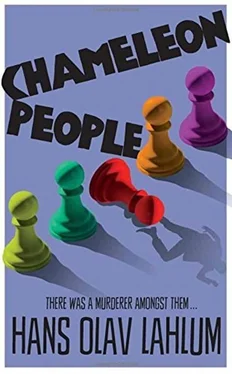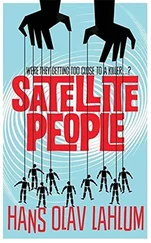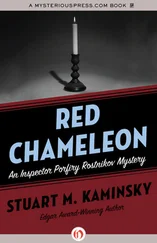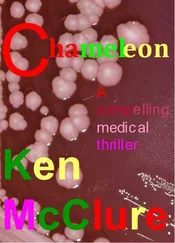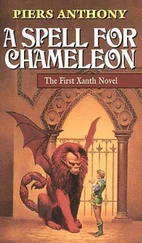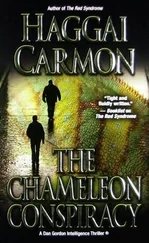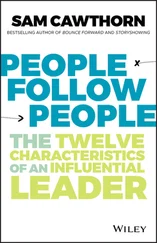After a brief pause, he carried on: ‘That was one of the hardest responsibilities in the years that I struggled to save the farm. As I see it, I managed to escape the madness in my father’s family and my sister inherited it all. Sweet Inger is as happy as can be here and she must be allowed to stay here until she dies. The thought that she might be forced to leave and hidden away in some asylum cubbyhole was too awful to bear.’
I told him I fully understood. And it struck me that Hauk Rebne Westgaard was the incarnation of a good family man, just without having his own family. Having met him and his sister, I wanted to believe that he was innocent, as regards to both the death of Eva Bjølhaugen in 1932 and the death of Per Johan Fredriksen in 1972. But I was still not certain. It seemed to me that he, too, was a complex man with many faces.
It was already ten past one by the time I got back to Oslo. There was a visitor waiting in my office, who had been sent there by my boss when he had demanded to talk to the head of the investigation. I was at first curious about my guest, only to be disheartened when I met him.
The lawyer Edvard Rønning Junior was sitting comfortably on my visitor’s chair, dressed as usual in a black suit, with a lorgnette and his briefcase on the table in front of him. This could have been from the 1950s, but the rest of him looked as though he had stepped straight out of the 1920s. The impression was in no way diminished when he started to talk.
‘Ah, there you are, Detective Inspector Kristiansen. And not before time. It is far from satisfactory that I have wasted the past thirty minutes sitting here waiting for you. It is even more unsatisfactory, however, for a defence lawyer not to know the name of his client, who is furthermore a minor, before the said client is dead. And none of this is made any better by the fact that the client died in police custody. Indeed, police scandal might be an appropriate phrase, if it is later proved that he was entirely innocent of the crime for which he stood accused. This would be highly unfortunate for both you and the police in general, and I will be strongly recommending that the deceased’s mother seeks compensation.’
I listened to him talk with a rising sense of panic. I had to admit that he had a point – it could be a very difficult case indeed.
Out loud, I simply said that it was hard to protect clients from themselves if they wanted to commit suicide and that we had spent a day and a half trying to identify his client as he refused to give us his name and no one had reported him missing. The question of guilt remained unresolved, but we were currently investigating other possible suspects and hoped that the lawyer would appreciate this.
This helped a little, but not enough. The lawyer looked at me pointedly over the top of his spectacles and answered: ‘The latter is, of course, positive, but in the current situation also a given. The investigation and your good self shall be granted sufficient time to establish the facts regarding the matter of his guilt. I do, however, expect to be informed immediately if there is any new evidence relating to the question of guilt that is of significance to my late client’s case. Furthermore, I also expect to be contacted in advance should you wish to talk to the deceased’s mother again. Her situation is, as I am sure you are aware, extremely difficult.’
I caught a whiff of idealism behind the lawyer’s formal language when he mentioned the mother. So I replied that I knew about the mother’s difficult situation, and that he would of course be informed as soon as the question of guilt with regard to his late client had been resolved.
The lawyer could not say that he was anything other than happy with that and so, after a brief, formal handshake, he left.
Edvard Rønning Junior’s visit lasted no more than five minutes. But it was still an uncomfortable reminder of the seriousness of my situation in terms of the investigation into the murder of Per Johan Fredriksen, and the tragedy of the boy on the red bicycle.
I no longer thought that the boy had committed the murder and did not think that he held the answer. But I was still curious about his role in the story and so decided that I would have a chat with the teacher he had apparently been so fond of. However, that would have to wait until the end of the school day. For now, having tried without success to find answers in Per Johan Fredriksen’s close family and his friends involved in the 1932 tragedy who were still alive, I wanted to get to know the businessman and politician.
The company, Per Johan Fredriksen A/S, had centrally located premises in an office block on Roald Amundsen’s Street, close to the National Theatre, but they were far smaller than I had expected. Three office clerks sat side by side, squeezed between the bookshelves in a room that was smaller than my office. The offices of the office manager and accountant were also surprisingly small and filled to bursting with lever arch files.
The office manager, Odd Jørgensen, was a slightly overweight, thin-haired besuited man with horn-rimmed spectacles, who looked around fifty or so. He was sitting half buried in a pile of rental contracts, but cleared his desk as soon as I arrived. He suggested that we might like to call in the accountant, Erling Svendsen, straightaway.
I agreed that this was a practical idea, even though there would not be much room round the table in Jørgensen’s office. Svendsen was a few years younger, had a bit more hair, a bit less girth and smaller glasses, but was otherwise remarkably like Jørgensen.
I started by asking about the company’s financial situation. Jørgensen left this to Svendsen, who gave a very sombre account, similar to the one I had heard from Kjell Arne Ramdal. The company was operating with a healthy profit and had a sound property portfolio, but in recent years had lost ground and momentum in a rapidly expanding market. The investments that had been made in the older flats, for which there was falling demand, were not sufficient and the administration was too overworked to keep a full overview of existing properties and possible new acquisitions.
Jørgensen nodded in agreement to this and then took over, having exchanged a glance with Ssvendsen.
‘To be frank, even though it is only days since he died, part of the problem was that Fredriksen was too shortsighted and averse to risk as a businessman. He liked to say that his strategy was to go for the best possible gains next month without the risk of losses this month. He was what is called a quarterly capitalist.’
I looked at Svendsen, who nodded vigorously. It was clear that the two men had worked together for a long time and were reading from the same page when it came to their assessment of the situation. Svendsen quickly took over where Jørgensen left off.
‘The offer he was given by Ramdal was extremely good and possibly a few million too high, if one was to add up the estimated value of the properties right now. We both recommended that Fredriksen should accept the offer. But he was hesitant, and we almost wondered if he was considering turning it down. Despite all his years in the capital, he was still a farmer at heart and was inherently sceptical about giving away land and property. In many ways, the business was his life’s work.’
I asked if they, for their part, were in favour of the possibility of a takeover. They exchanged a quick look and then nodded simultaneously. The office manager was the one who spoke.
‘We and the rest of the office staff were all in favour of it. Ramdal is known to be a demanding but fair boss and open to suggestions from his staff. We hoped that we might get a bit more space, less overtime and, more than anything, slightly more humane working conditions.’
Читать дальше
